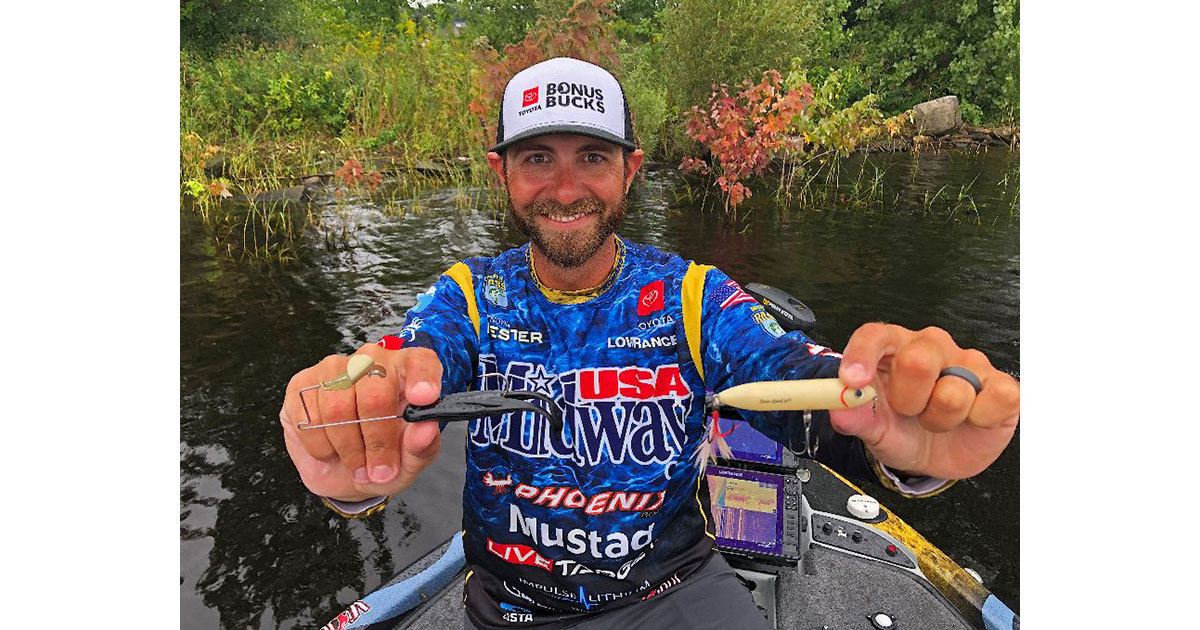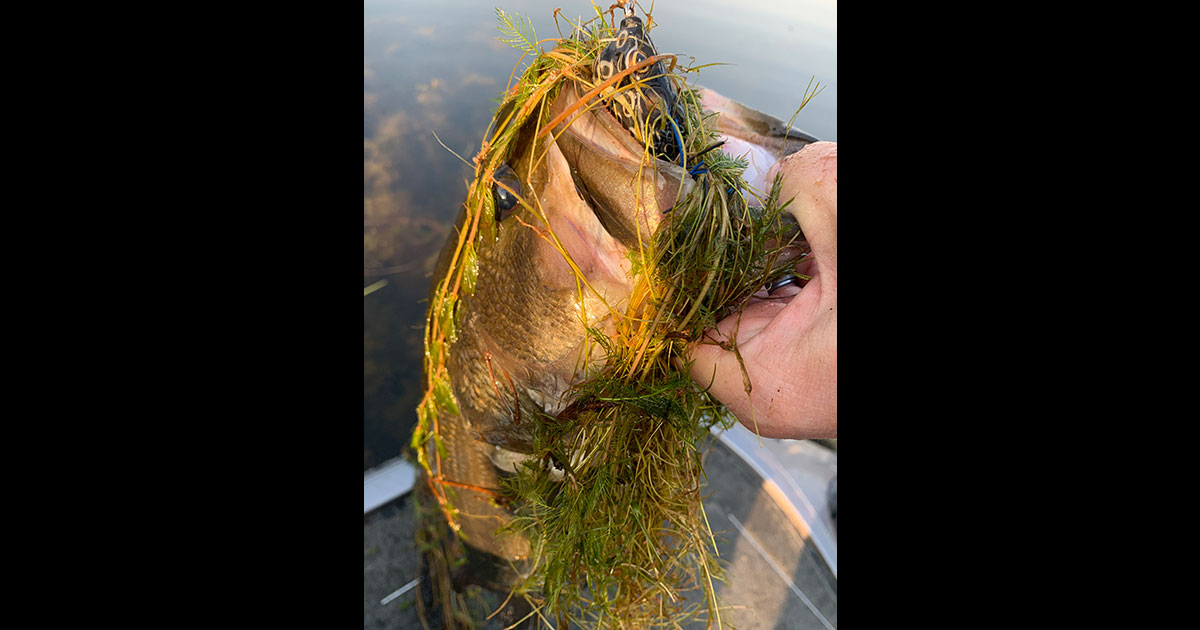- Details
BFHOF Report
Bass fisherman have a great opportunity to bid on tackle, lures and gear, tournament pro jerseys, exclusive fishing trips with expert anglers and more in the Bass Fishing Hall of Fame’s online auction presented by Major League Fishing.
It’s easy. Log-in with your smartphone, tablet or computer at https://one.bidpal.net/bfhof/browse/all to access the auction-dedicated website or text BFHOF to 243-725.
The website will be ‘live’ from 9 a.m. EST Friday, Sept. 22 through 9 p.m. EST on Thursday, Sept. 28, the night when many involved in the bass fishing world will be gathered to celebrate the induction of Glen Andrews, Bruce Holt, and Michael Iaconelli into the Bass Fishing Hall of Fame, located within Johnny Morris’ Wonders of Wildlife Aquarium & Museum.
- Details
By Al McGuckin
 Brandon Lester
Brandon Lester
Team Toyota’s Brandon Lester endured more stress in the final days of August than a lone goby surrounded by a school of fat smallmouth.
Three days after learning he probably would not qualify for the Bassmaster Classic for only the second time in his fantastic 10-year career, his mega-cute young daughter was hospitalized for a horrible stomach virus, and then, just hours after she began to heal, his father was hospitalized over serious pulmonary concerns.
So, here’s to hoping September brings far more smiles, and some time on the water to decompress for Lester. One thing’s for certain, the next time he launches his boat, there will be two time-proven topwaters tied on.
“No matter where you live, September signifies the first month of fall. It’s that time of year when we get our first cool nights, and lots of things start kicking into a bit of a different gear. To me, that means you better key on baitfish imitators and a trolling motor that’s in fairly constant forward motion,” says Lester.
Covering water with baits that appeal to bass looking skyward is the key, so Lester chooses a buzzbait and Super Spook Jr. as two lures all bass anglers should try during the calendar’s ninth month.
- Details
Seaguar Report
 Largemouth bass
Largemouth bass
One of the surefire ways to get around bass is to fish around the grass. They love the stuff and there's always a percentage of the population living near the green stuff.
Many different lures work, but Seaguar pros and Bass Pro Tour anglers Gerald Spohrer and Mark Daniels, Jr. focus on efficiency. Both spent their fishing upbringings around grass, with Daniels learning bass fishing on the famed California Delta and Spohrer spending his time in the bayous of Louisiana, two regions known for expanses of aquatic vegetation.
Spohrer prefaced his talk on grass fishing with a simple outlook for baits, rods, and lines. "You need to have the right tool for the job and if it's not working, you need to try something that does the job better," he said. "Everything comes down to feel and you want to be able to fish effectively without getting stuck in the grass the whole time. You also want to make sure that you're never underpowered and can get the fish out of it."
To do this, Spohrer and Daniels each pick the right gear for the vegetation in front of them, varying it based on the vegetation type and thickness.
Punching Matted Vegetation
Sometimes, especially in the dead of summer, the grass is so thick that it's topped out and forms a mat. One of the only ways to fish efficiently in these situations is to crash right through the grass with the help of a heavy tungsten weight.
This is one of Daniels' favorite ways to fish and he'll punch a small crawfish imitating plastic paired with weights starting at ¾-ounce and up to over 2 ounces depending on the thickness of the grass. For line, he always begins with 50 lb Seaguar TactX, a 4-strand braided line with a rough textured finish to help cut through the grass.
"I start with 50 and always advocate that with punching because it's all about efficiency and how many times you can punch through the mat in a day," he said. "50 lb with a smaller diameter will penetrate the mats easier than 65 lb, but sometimes you have to use the heavier line if you use weights over 2 ounces and around huge fish. TactX is legit and tears right through the grass on the hookset and that makes a big difference in landing more fish."
Spohrer is also a big proponent of punching and uses a similar approach but differs in his line selection, opting for the 8-strand Seaguar Smackdown braid in a 65 lb test. "I love how smooth it is and how easily it comes off the reel," he said. "It's very quiet coming through the guides, and I like that. TactX is great, but a little louder, but it has its place for several techniques."
Frogs and Other Topwaters
Another great way to fish around thick grass is with a hollow body frog. It's fun and effective at fishing around matted grass, lily pads, and more.
Spohrer prefers to fish his frogs on 50 lb TactX. "I use it when throwing a frog around pads because it slices right through them when you make a strong hookset," he said. "Smackdown does cast a little bit better, in my opinion, but it doesn't cut through grass as easily as TactX does. It's my choice for more open areas or when fishing a frog around isolated cover like overhanging trees, docks, and scattered grass."
Daniels uses the same approach and starts with 50 lb TactX instead of the 65 lb that some prefer. "Your castability is going to be much better because of the smaller diameter," he said. "I know if I hook one and it buries me in the grass, it's not going anywhere, and I can get him out."
Both anglers will also mix in other topwaters such as buzzbaits, plopping baits, and prop baits and target holes in the grass and right along the grass lines.
Daniels fishes these baits on braided line, 40 lb Smackdown, and will add a short 8 to 12-inch leader of 20 lb Seaguar AbrazX fluorocarbon for the prop bait and plopper.
"I like the Smackdown for these topwaters because it casts so well," he said. "The fluorocarbon leader is necessary for baits with treble hooks and props because the limp braid tends to wrap up on them when you work the bait. That short leader of fluorocarbon is stiff enough to keep it in front of the bait and will eliminate a lot of those issues."





